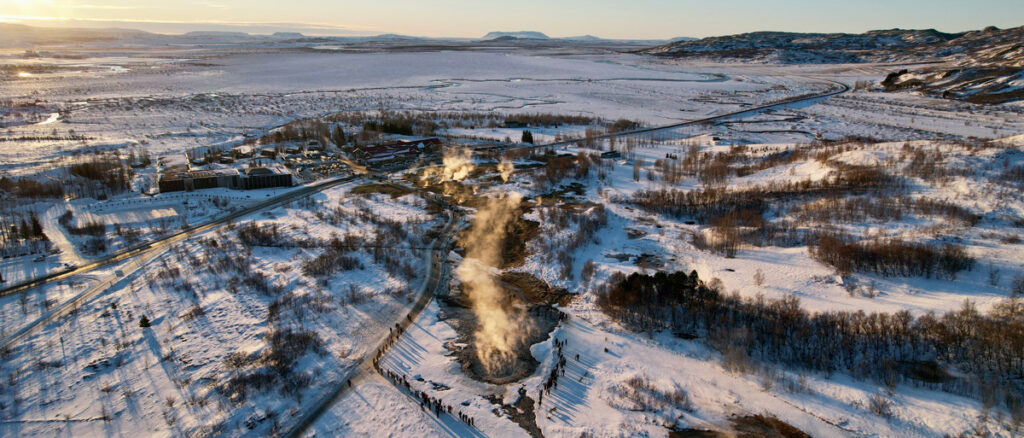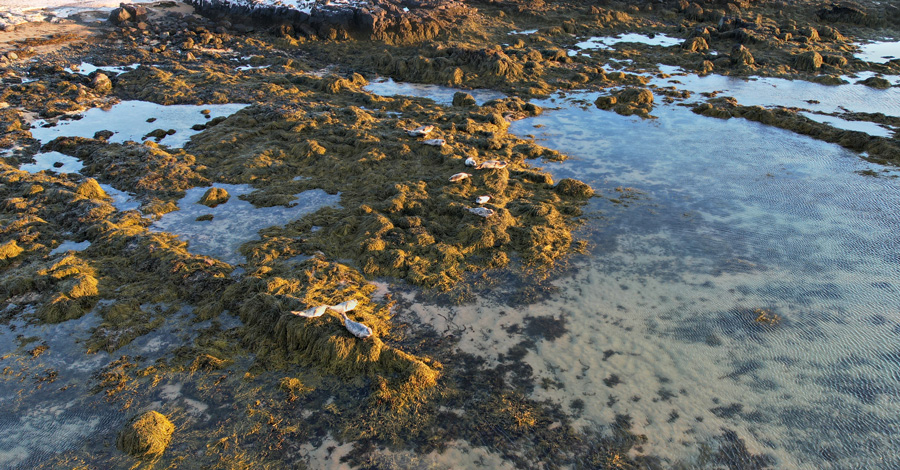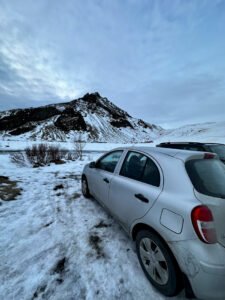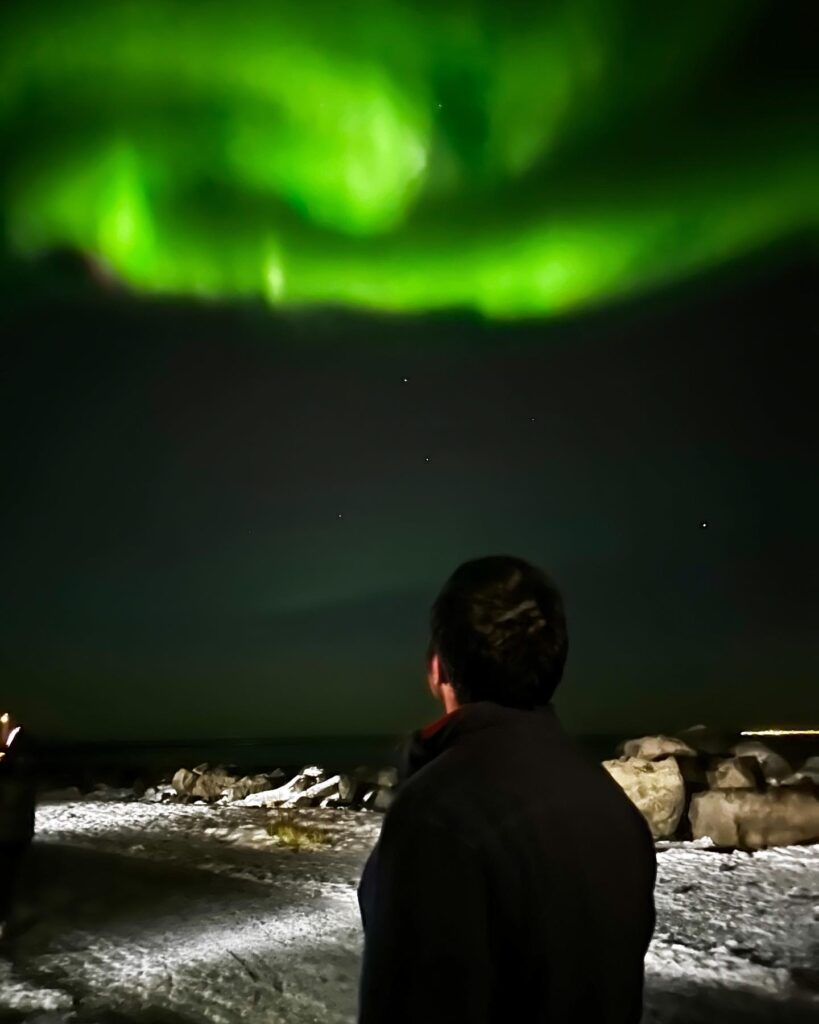Although we experienced a few setbacks on our first day, we had a wonderful trip. Unfortunately, due to a snowstorm, we had to postpone our plans on the first day. We were able to visit places in the following days. However, encountering the changing weather conditions of this region was also a great opportunity to discover the beauty of nature. If you want to quickly add all the travel destinations to your Google Maps list, you can access “Iceland Attractions” via the link https://goo.gl/maps/FcP9N7YTSrm45kma9.
We came to this beautiful country with an approximately 45€ plane ticket via Norway, and we were enchanted by the unique beauty of the Northern Lights. I am preparing the second video to share our exciting moments with you. As an Iceland travel guide, it is a wonderful country that needs to be explored, and you can follow more of my short and active posts on my Instagram account at https://www.instagram.com/yarkinguloglu/.
We came to this beautiful country with a flight ticket of about 45€ through Norway, and Iceland enchanted us with the unique beauty of the Northern Lights. As an Iceland travel guide, I am preparing the second video to share our exciting moments with you. Iceland is a country famous for its natural beauties such as glacial lakes, waterfalls, volcanoes, and the Northern Lights, so there are many places to explore for travelers.
I wanted to share some of the best places to visit in Iceland with you:
1. Blue Lagoon: One of the world’s most famous thermal pools, the Blue Lagoon is a popular attraction for tourists. It’s a perfect place to swim in the mineral-rich blue waters and enjoy beautiful views.
Location: https://goo.gl/maps/8LghLczdnBWkTypi6
2. Thingvellir National Park: Thingvellir National Park, which is on the UNESCO World Heritage List, is one of Iceland’s most important historical and natural sites. The park includes many lakes and rivers, including the country’s largest lake, Thingvallavatn.
Location: https://goo.gl/maps/6J5rLquA4gSKhDzu5
3. Gullfoss Waterfall: Gullfoss, one of Iceland’s most famous waterfalls, is a two-stage waterfall and a popular place for tourists to visit. It is located in the Golden Circle of Iceland.
Location: https://goo.gl/maps/WFGqENGrZRdxdRcs5
4. Vatnajökull National Park: Vatnajökull Glacier, one of Iceland’s natural beauties, is one of the country’s largest glaciers. You can take a hike to explore the beauty of nature, including glaciers, ice caves, and traces of avalanches in the park.
Location: https://goo.gl/maps/orncXemmNSsE9Xy96
5. Akureyri: Akureyri, Iceland’s second-largest city, is a popular place for tourists. The city has many tourist attractions, such as historic buildings, museums, churches, and nightlife.
Location: https://goo.gl/maps/auRy6Zar96A4PnnC6
6. Jökulsárlón: Jökulsárlón is a natural beauty area surrounded by glaciers and glacial lakes in Iceland. You can take boat tours to watch these magnificent landscapes.
Location: https://goo.gl/maps/9a8H38MtZ5ipBWkJ8
7. Reykjavik: Reykjavik, Iceland’s capital city, is a popular place for tourists with its colorful buildings, street art, and tourist attractions. There are many things to do in the city, such as concerts, festivals, and other events.
Location: https://goo.gl/maps/XTbkdQsXwzHy8bLg8
8. Parking for Sólheimasandur Plane Wreck: Sólheimasandur Plane Wreck is a popular tourist attraction in Iceland, attracting thousands of visitors every year. The site is home to the wreckage of a US Navy DC-3 plane that crashed onto the black sandy beach in 1973. Visitors can explore the wreckage and take stunning photos of the plane against the dramatic landscape.
Location: https://goo.gl/maps/dbiGJQ5ZJ3azgYwm7
9 . Geysir

Geysir, located in the Haukadalur Valley in southwestern Iceland, is one of the country’s most famous tourist attractions and is named after the natural springs that spout water at regular intervals. It is the largest geyser in Iceland, with a height of approximately 20 meters, and regularly spouts water into the air, mesmerizing tourists. The second-largest geyser in Iceland, Strokkur, erupts approximately every 15 minutes.
Location: https://goo.gl/maps/mzP84KDyVfjaXuxV7
10. Krónan (Grocery Shopping in Iceland)
Krónan is one of Iceland’s supermarket chains. If you want to go grocery shopping and meet your daily needs, you can go to the nearest Krónan market.
Accommodation in Iceland
Hotel prices in Iceland are quite high, so I rented a room with some fellow travelers I met there and paid €27 per night.
Where I stayed: Iceland Comfort Apartments
Link: https://www.booking.com/hotel/is/north-star-apartments.en-gb.html
If I hadn’t stayed there, I would have considered staying at a hostel. The hostel’s name is Kex Hostel, and I found it for €36 per night. The hostel is centrally located.
Hostel link: https://booking.com/hotel/is/kex-hostel-reykjavik1.en-gb.html
Restaurants in Iceland
To be honest, the cheapest restaurant I found was Vitabar. You can find more detailed locations on my map list, but I can say that this is one of the cheapest places in the center 🙂 I paid approximately 1,400 Icelandic Krona (€10) for a hamburger and fries meal.
Location: https://goo.gl/maps/Qs459u9YmLYRMkzNA
The World’s Largest Vegan Market in Iceland
The market’s name is Vegan búðin. The market’s website is https://veganbudin.is/.
Location of the market: https://goo.gl/maps/RBF8fNUX7hCuf2NX8

You can go to Ytri Tunga 🙂 I went there skeptically, but I saw it!!
Seals, especially those living in cold seas, are large, fatty and furry animals. These animals usually live in coastal areas and are an important source of fishery. Seals are among the natural beauties for many people and have an important impact on marine tourism. However, in some regions, the conservation of seal species is a major problem due to hunting for their meat and fur. Therefore, many efforts are being made worldwide for the conservation of seals.
Location: https://goo.gl/maps/XaqCzeWnXgwznnLP9
You can plan your trip to Iceland through this article to discover the beauty of Iceland.
Also, I have prepared a very nice list of places to visit in Iceland for you to follow. You can follow the list on your Google Maps profile via the Google Maps link and easily access the list.

Renting a Car in Iceland
Driving a car in Iceland during winter is really difficult. Since the roads outside and inside the city are small, icing and snow make it even more difficult. Therefore, if you want to rent a car in winter, you really need to be careful while driving.
Also, since the rules are strict, you should be careful not to get fined. You can search on Google for free parking applications. During the period we were there, many places were free after 6 pm.
We rented the car for 30€ per night. We rented it by contacting someone there without having any car. We also bought the gasoline for approximately 2.5€ per liter.
Contact Information 👋🏻🤗
Email: info@yarkinguloglu.com
Instagram: https://instagram.com/yarkinguloglu
Youtube: https://youtube.com/yarkinguloglu
Twitter: https://twitter.com/yarkinguloglu
I also have a company that I work remotely for. We provide services on Digital Marketing. If I am around, I would be happy to have a coffee with you 🤗
Company Website: https://pastell.co/
Where We Can Watch Northern Lights in Iceland?

Iceland is one of the best places in the world to witness the breathtaking display of the Northern Lights or Aurora Borealis. The best time to see this natural phenomenon is from late August to mid-April, when the nights are long and dark.
I could see from Grótta Island Lighthouse. This place is near center of Reykjavik. It is visible from center too. But the best point is here.
Location : https://goo.gl/maps/5BahorzFyMzrkmV88
Some of the popular places to see the Northern Lights in Iceland are:
Thingvellir National Park – Located about 40 km from Reykjavik, this UNESCO World Heritage Site offers a stunning backdrop for Northern Lights viewing.
Reykjavik – The capital city of Iceland is not immune to the beauty of the Northern Lights. The lights can often be seen from the outskirts of the city.
Akureyri – The charming town of Akureyri, located in the north of Iceland, is known for its clear skies, making it a perfect spot for aurora hunting.
Jokulsarlon Glacier Lagoon – This beautiful glacier lagoon in southern Iceland provides a unique and awe-inspiring location for viewing the Northern Lights.
Skaftafell National Park – This national park, located in southeastern Iceland, is known for its stunning landscapes and is a popular spot for Northern Lights viewing.
Remember to check the aurora forecast, dress warmly, and head away from city lights to get the best experience of the Northern Lights in Iceland.
The Best App For Aurora / Northern Lights
I think this is really nice app for finding Aurora. Hello Aurora is a mobile app that helps users discover the beauty of the Northern Lights or Aurora Borealis. This app is designed to provide users with real-time updates on aurora sightings in different parts of the world. It also provides a user-friendly interface that allows users to explore the science behind the Aurora Borealis.
With Hello Aurora, users can set up notifications for when the Aurora Borealis is visible in their area. The app also includes a map feature that shows the current aurora activity level in different regions around the globe. Users can learn about the science behind the aurora phenomenon through educational content and stunning imagery.
Overall, Hello Aurora is an excellent app for anyone interested in astronomy and the beauty of nature. Whether you are an avid stargazer or simply curious about the Aurora Borealis, this app is a great tool for exploring the Northern Lights.
Hello Aurora App Website : https://hello-aurora.com/ you can download from website (App store or Google Store)
Iceland: Frequently Asked Questions
- What is the best month to visit Iceland?
The best month to visit Iceland largely depends on your personal preferences and what you want to experience during your trip. Generally speaking, the summer months of June, July, and August are the most popular for visitors due to the mild weather and the long daylight hours, allowing for plenty of time to explore the stunning natural landscapes. However, if you are looking to witness the Northern Lights, the best time to visit is during the winter months of November through February. Additionally, if you want to experience Iceland’s unique festivals and cultural events, consider visiting during the spring or fall months, as there are numerous celebrations and activities taking place during these seasons. Ultimately, the best time to visit Iceland will depend on your individual interests and travel goals.
- How many days in Iceland is enough?
The ideal number of days to spend in Iceland depends on your travel goals and what you want to experience during your trip. If you are looking to see the main attractions such as the Golden Circle, Reykjavik, and the Blue Lagoon, then a 3-4 day trip would be sufficient. However, if you want to explore more of Iceland’s natural beauty and go off the beaten path, then you may want to consider spending 7-10 days or even more. This would allow you to venture further into Iceland’s remote regions, such as the Westfjords, the Highlands, or the Ring Road. It’s also important to note that Iceland’s weather can be unpredictable, so giving yourself some extra time can allow for flexibility in your itinerary in case of any unexpected weather events. Ultimately, the duration of your trip to Iceland will depend on your individual interests and travel goals.
- Is 3 days enough for Iceland?
While 3 days in Iceland can give you a taste of what the country has to offer, it may not be enough time to fully experience everything Iceland has to offer. With only three days, you could explore the main attractions such as the Golden Circle, Reykjavik, and the Blue Lagoon. However, you would not have enough time to venture far outside of the capital region or to explore Iceland‘s more remote areas. Additionally, unpredictable weather could potentially disrupt your plans, so it’s important to have some flexibility in your itinerary. Overall, while 3 days in Iceland can be a worthwhile trip, it’s recommended to plan for a longer trip if possible to fully experience all the natural beauty and unique experiences that Iceland has to offer.
- How expensive is Iceland for tourists?
Iceland is known for being an expensive destination for tourists, due to its remote location, high cost of living, and reliance on imported goods. Accommodation, food, and transportation can all be quite pricey, especially in the peak travel season. However, there are ways to reduce costs, such as staying in hostels or camping, cooking your own meals, and using public transportation or car rental services. Additionally, many of Iceland’s natural attractions, such as waterfalls, hot springs, and hiking trails, are free to access. Overall, while Iceland can be an expensive destination, it is possible to manage costs and plan a budget-friendly trip with some careful planning and research.
- What is the best month to see Northern Lights in Iceland?
The best time to see the Northern Lights in Iceland is during the winter months of November through February. During this time, there are long periods of darkness and clear skies, which are essential for viewing the aurora borealis. Additionally, while the Northern Lights can be seen throughout Iceland, the northern regions, such as Akureyri and Myvatn, tend to have the best viewing conditions due to their proximity to the Arctic Circle. It’s important to note that while the Northern Lights can never be guaranteed, planning your trip during the winter months and being patient and flexible with your itinerary can increase your chances of witnessing this breathtaking natural phenomenon.
- What are the chances of seeing the Northern Lights in Iceland?
The chances of seeing the Northern Lights in Iceland depend on several factors, including the time of year, weather conditions, and location. The best time to see the Northern Lights in Iceland is during the winter months of November through February, when the nights are longest and the skies are clear. However, even during this time, there is no guarantee of seeing the Northern Lights, as they are a natural phenomenon and can be affected by factors such as solar activity and cloud cover. It’s important to be patient and flexible with your itinerary, as sometimes it takes several nights of waiting and searching for the right conditions to see the aurora borealis. However, many visitors to Iceland are able to witness the Northern Lights during their trip, making it a worthwhile and unforgettable experience.
- Which part of Iceland is best for Northern Lights?
The northern part of Iceland is generally considered the best region for viewing the Northern Lights. The areas around Akureyri and Lake Myvatn are particularly popular due to their location close to the Arctic Circle, which provides optimal viewing conditions. Additionally, these regions have lower levels of light pollution compared to the capital area, making it easier to see the aurora borealis in all its glory. It’s important to note that while the Northern Lights can never be guaranteed, planning your trip during the winter months and being patient and flexible with your itinerary can increase your chances of witnessing this breathtaking natural phenomenon in Iceland.
- What date can you see the Northern Lights in Iceland?
The Northern Lights can potentially be seen in Iceland from late August to mid-April, with the peak viewing season being from November to February. However, the exact dates and times of the Northern Lights are unpredictable, as they are a natural phenomenon that is dependent on solar activity and weather conditions. To increase your chances of seeing the Northern Lights, it’s important to plan your trip during the winter months, when the nights are longest and the skies are clearest. Additionally, it’s recommended to stay in a location with minimal light pollution, such as the countryside or northern regions of Iceland, and to check the aurora forecast and weather conditions regularly during your trip.


